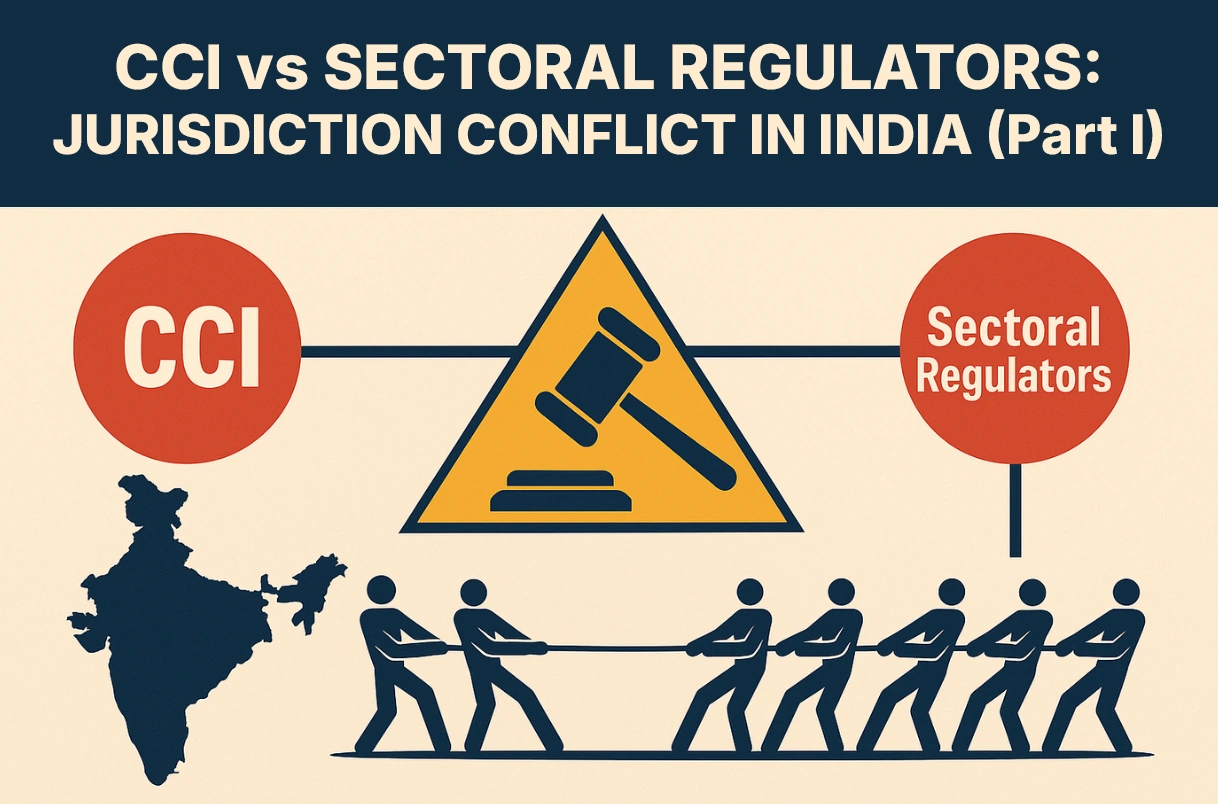Jurisdictional Conflict in Competition Law: CCI vs Sectoral Regulators in India (Part 1)

By – Sakya Singha Chaudhuri and Asmita Narula
Table of Contents
Introduction
The introduction of the New Economic Policy in the year 1991 in India marked a significant shift in our economic landscape, from a controlled and closed economy to a liberalized and open one. This led to the establishment of sectoral regulators to ensure fair practices and prevent monopolies in specific sectors.
The emergence of the Competition Commission of India (CCI) as a cross-sectoral anti-trust regulator, has led to several instances of jurisdictional conflicts between CCI and other specialized sectoral regulators. The mandate of the CCI is to eliminate anti-competitive practices, promote competition, and protect consumer interests in all business enterprises, while the sectoral regulators focus on specific sectors and industries – this overlap has been under judicial scrutiny for over a decade, with courts attempting to balance the roles of both the regulators. The conflict is evident in sectors like telecom, copyright, patents, electricity, professional services, etc., with varying court rulings on the extent of the jurisdiction of the CCI and the sectoral regulators.
The present article explores the approach of court with regard to such jurisdictional conflict. This three-part series begins with an overview of the jurisdictional conflict between CCI and sectoral regulators, focusing specifically on the telecom and broadcasting industry. Subsequent parts will explore judicial decisions involving other sectors.
Adoption of the New Economic Policy, 1991
With the adoption of the New Economic Policy (NEP) in 1991 with three broad goals – liberalisation, privatisation and globalisation, the Indian economy drastically changed – from controlled and closed to liberalized and open economy. One of the most important objectives of the NEP was to attract foreign investment and private entrepreneurship into the Indian economy.
The introduction of major reforms in various sectors of the Indian economy led to the gradual setting up of sectoral regulators with the primary objective of ensuring fair practices, preventing monopolies and protecting the consumers. The Telecom Regulatory Authority of India (TRAI) was set up in 1997, Central Electricity Regulatory Commission (CERC) was set up in 1998, Insurance Regulatory and Development Authority (IRDA) was set up in 1999, Airports Economic Regulatory Authority (AERA) was set up in 2008, etc.
Jurisdiction of the CCI under the Competition Act
Capitalism, on one hand, gives the required freedom to the market forces to determine the prices leading to increased productivity and growth, and on the other, it gives rise to the tendency for monopolisation or abuse of dominant position. A business is considered to be in a dominant position when it has a significant market share and enjoys a position of strength thereby having the ability to act independent of market forces and affecting its competitors or consumers to its advantage.
With the rise of capitalism in the Indian economy, a need was felt to evolve the competition law in the country to regulate tendencies that can adversely affect effective competition.
The first legislation to regulate capitalism in India was the Monopolies and Restrictive Trade Practices Act, 1969 (MRTP Act). It was enacted with the objective to ensure that the operation of the economic system does not result in the concentration of economic power to the common detriment, to control the monopolies and to prohibit monopolistic and restrictive trade practices.
However, with the international economic developments in competition laws, the MRTP Act was found lacking in certain areas. There was a need to shift focus from curbing monopolies to promoting competition and eliminating anti-competitive practices.
The Competition Act was enacted in 2002 with the objective of preventing practices having an adverse effect on competition, promoting and sustaining competition, protecting the interests of the consumers and ensuring freedom of trade by the market participants.
CCI is entrusted under the Competition Act India with four key functions: eliminating anti-competitive practices, promoting competition, protecting consumer interests, and ensuring trade freedom. Notably, the proceedings under the Competition Act are in rem, meaning they impact public interest at large. Notably, the proceedings under the Competition Act are proceedings in rem which affect the public interest1.
CCI vs Sectoral Regulators: Overlapping Jurisdictions and Legal Scrutiny
The CCI has the power to inquire into any possible instances of cartelization or abuse of dominance by any entity or person, either on its own motion or on the basis of information received by it or a reference made to it by the Central or State Government or any statutory authority.
The nature of functions carried out by CCI often results in jurisdictional conflict between the sectoral regulators, particularly those in the infrastructure sector, and the CCI. Both the CCI and the sectoral regulators have common objectives but different legislative mandates, goals, perspectives and approach.
The jurisdictional conflict arises mostly on account of the overlap in such statutory demarcation in matters that fall within the scope of both the sector regulator and CCI.
Conflict with the Telecom Regulatory Authority of India (TRAI)
One of the most prominent examples of jurisdictional conflict involving the CCI and a sectoral regulator occurred in CCI v. Bharti Airtel2, which focused on regulatory overlap with the Telecom Regulatory Authority of India (TRAI).
Reliance Jio had filed information before the CCI alleging cartelization by three competing major telecom operators, Airtel, Vodafone and Idea, to hinder its entry into the market by not augmenting the Point of Interconnection (POI) in violation of the agreements and TRAI’s directions.
Prior to filing information with the CCI, Reliance had also approached TRAI, where the issue was pending. The CCI directed an investigation, which was challenged before the Bombay High Court on the ground of CCI’s lack of jurisdiction.
The High Court adopted a balanced approach by maintaining the ‘comity’ between the sectoral and market regulator and held that the question of interpretation inter alia of the contract clauses, interconnection agreements, etc. are to be settled by the sectoral regulator and the machinery under the Competition Act can only be invoked after the determination of these facts.
The Supreme Court upheld this decision and observed as follows:
- TRAI is a telecom recommendatory, advisory and regulatory body, established with the objective of inter alia exercising control and supervision, protecting the interests of service providers and consumers, ensuring technical compatibility and effective inter-relationship between service providers, ensuring compliance of licence conditions by them and ensuring fair competition amongst them.
- Questions like whether there was an obligation to provide POIs, when was it to commence, whether the demand for it was reasonable, whether there was any denial to provide it, whether sufficient POIs were provided, etc., are first to be decided by TRAI as the said jurisdictional aspects come within TRAI’s domain.
- Unless TRAI finds fault on the said aspects, the matter cannot be taken further based on the alleged violations, even if it is assumed that the CCI has jurisdiction to deal with the information filed before it. TRAI is better equipped as a sectoral regulator to deal with these jurisdictional aspects. Further, it may lead to conflicting views since TRAI was already seized of the matter.
- TRAI does not have the exclusive jurisdiction to deal with matters involving anti-competitive practices to the exclusion of CCI in the telecom sector. It is within the CCI’s ambit to determine whether the conduct of the competing telecom companies was unilateral, or a collective action based on an agreement, and whether a particular agreement will have appreciable adverse effect on competition. These functions come within the domain of CCI. If TRAI comes to a finding that a particular activity was anti-competitive, the consequences will not be limited to TRAI and will also extend to the Competition Act.
Case: Star India Private Limited v. Competition Commission of India
Complaints were filed against Star India Private Limited and Sony Pictures Network India Private Ltd., alleging anti-competitive market practices owing to their strategic position in the broadcasting sector by imposing unfair terms and limiting their services to less favoured operators such as Noida Software3.
Investigation directed by CCI, was challenged before the Bombay High Court inter alia on the ground that CCI did not have jurisdiction in view of the law laid down in Bharti Airtel since TRAI had not returned a finding on the jurisdictional aspects.
The High Court set aside CCI’s order since there was no finding on necessary jurisdictional facts by sectoral regulator.
Case: Coal India Ltd. v. Competition Commission of India
Recently, in the year 2023, the Supreme Court has again adopted a balanced approach between the jurisdiction of the CCI and the Controller of Coal in Coal India Ltd. v. Competition Commission of India, wherein it was held that the Controller of Coal may have jurisdiction however, that by itself does not oust the jurisdiction of the CCI.
CCI can also take action suo motu under the Competition Act where there is evidence of anti-competitive conduct.
Conclusion
Jurisdictional conflict in competition law—especially between the Competition Commission of India (CCI) and various sectoral regulators—remains a complex and evolving issue. With the Competition Act India granting CCI wide-ranging powers to ensure free and fair markets, and sectoral regulators possessing deep technical oversight within their respective domains, disputes over regulatory overlap have become increasingly common.
Courts in India have largely favored a harmonious interpretation—attempting to balance the jurisdiction of CCI with the specialized functions of sectoral regulators. While decisions vary across sectors such as telecom, electricity, and intellectual property, the judiciary has consistently acknowledged that both institutions play complementary roles. The principle of comity between regulators has guided landmark rulings, though ambiguity in statutes continues to leave room for contestation.
A uniform solution has yet to be reached. Provisions under Sections 21 and 21A of the Competition Act India—which allow cross-reference between regulators—remain underutilized and non-binding. However, recent amendments empowering CCI to enter into memoranda of understanding with statutory regulators could provide a foundation for future coordination and clarity.
As this first part demonstrates, judicial interpretation remains central to managing the regulatory overlap between the Competition Act India and sector-specific legislation.
Stay tuned for Part 2, where we dive deeper into jurisdictional disputes involving the Patents Act, Copyright Act, and Electricity Act—shedding light on how courts are shaping India’s competition law landscape.
FAQs
-
What is the role of the Competition Commission of India (CCI)?
Established under the Competition Act, 2002, the CCI is India’s competition regulator. It aims to eliminate anti-competitive practices, sustain market competition, protect consumer interests, and ensure trade freedom across all industries. It also plays an advisory and advocacy role for policy improvement.
-
How does the CCI’s jurisdiction conflict with sectoral regulators?
Sectoral regulators, formed post-1991 economic reforms, oversee industry-specific conduct. Many of them are empowered by their respective laws to regulate monopolistic behavior and promote fair practices. Since the CCI has cross-sectoral jurisdiction, overlapping mandates often lead to conflict—especially when both regulators claim authority over similar competition-related issues.
-
What are some landmark cases related to CCI’s jurisdiction?
Key cases include CCI v. Bharti Airtel, Coal India Ltd. v. CCI, HT Media v. Super Cassettes, Telefonaktiebolaget LM Ericsson (DB), ICAI v. CCI, and recent proceedings like Torrent Power Ltd. These highlight jurisdictional disputes between the CCI and sectoral regulators.
-
Can the CCI overrule decisions by sectoral regulators?
No. The CCI is not an appellate body. However, due to jurisdictional overlap, it has occasionally proceeded independently, especially when addressing anti-competitive conduct beyond the sector regulator’s scope.
-
What does the Supreme Court say about the jurisdictional conflict between CCI and TRAI?
In Bharti Airtel, the Court held that TRAI should first examine telecom-related contractual issues, but it did not oust CCI’s jurisdiction. The CCI may proceed only after TRAI determines technical compliance. A similar balance was maintained in Coal India Ltd. v. CCI (2023).
-
How does the Competition Act interact with the Electricity Act in India?
Courts have generally held that tariff and technical matters lie within the Electricity Regulatory Commissions’ purview. However, the CCI retains jurisdiction over competition issues like abuse of dominance, with both Acts interpreted harmoniously in practice.
-
What is Section 60 of the Competition Act?
Section 60 gives the Competition Act overriding effect over other inconsistent laws, ensuring its provisions apply even if they conflict with other legislation.
-
What powers does the CCI have under the Competition Act?
The CCI can investigate anti-competitive agreements, abuse of dominance, and regulate mergers or combinations. It can impose penalties, issue cease-and-desist orders, and refer or receive issues from other authorities. It also exercises quasi-judicial powers and can frame regulations for enforcement.
-
How is CCI’s jurisdiction affected by the Patents Act or Copyright Act?
Section 3(5) of the Competition Act protects certain IP rights. While the CCI may act against unreasonable licensing conditions, courts have ruled that specialized issues (like compulsory licensing under the Patents Act) fall within the jurisdiction of respective authorities. Conflicting interpretations remain under judicial review.
-
What steps can be taken to resolve jurisdictional overlap in India?
Harmonization of laws through legislative amendments is key. Courts favor a balanced approach, but ambiguity persists. The Competition (Amendment) Act, 2023 allows CCI to enter into MoUs with statutory bodies for coordinated regulation. Provisions under Sections 21 and 21A also allow cross-references, though they are currently underutilized.
References
- Sameer Agrawal v. Competition Commission of India and Others, (2021) 3 SCC 136
- (2019) 2 SCC 521
- (2023) 10 SCC 345


